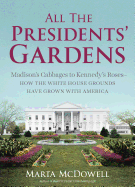
The White House in Washington, D.C., sits on 18 acres above the Potomac River, a site selected by George Washington, who never saw the house or gardens completed. Not that they ever stayed complete for long: like much of the United States, this residence has been regularly rebuilt and renovated ever since the first gardens were installed in 1809, then torched along with the house by British soldiers in 1814.
"The White House gardens mirror the country's horticultural aspirations over time," writes garden historian Marta McDowell (Beatrix Potter's Gardening Life). This premise allows her to skim through most of the history of United States gardening in All the Presidents' Gardens. These gardens have led and followed fashions, and been altered by the influential landscape architects and plant breeders of every period. This book is full of interesting facts and anecdotes: the sheep that mowed the lawns as late as World War I, John Quincy Adams's morning dip in the Potomac, Helen Taft's cherry trees, the decline and rebirth of the kitchen gardens, and Teddy Roosevelt's son roller skating into a presidential meeting with an armload of snakes. There is a variety of beautiful and informative illustrations on almost every page, a good index, and appendices of gardener biographies, plant lists and recommended reading. Gardeners and fans of cultural history will enjoy this book, the more so since McDowell avoids politics, writing: "whether gardeners lean right or left, blue or red, we are united by a love of green growing things and the land in which they grow." --Sara Catterall

